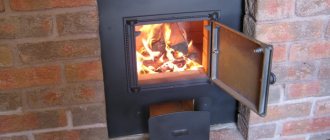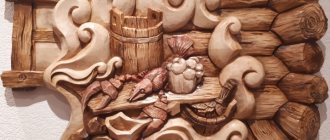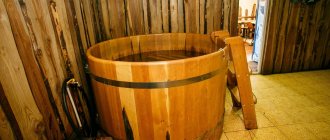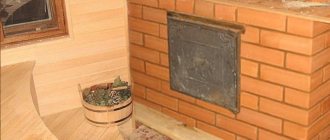A steam gun for a sauna stove is a device designed to supply water to the hottest part of the stove in order to obtain the dryest, finely dispersed steam. It is usually made of metal pipes, which are located inside the heater in such a way that water can be poured in at one end and steam can be obtained at the other.
There are designs that provide for the second end of the pipe to be brought out, and others are designed in such a way that all the water poured into the heater remains there to completely evaporate upon contact with overheated stones.
Are there any fundamental differences between steam generators for baths, saunas and hammam?
Many people are interested in the question, what is the difference between steam generators for a bath, sauna or hammam? Since all three types of structures are intended not only for washing, but also for healing the body, their action is based on the formation of steam. The difference between a bathhouse, a sauna and a hammam is the amount of steam produced, its temperature and humidity level.
Temperature conditions of different types of steam rooms:
- A Finnish sauna must have dry heat - the temperature ranges from 80 to 140°C, the humidity level is from 1 to 15%.
- There must be wet steam in a Turkish hammam - the temperature is maintained at 45°C - the humidity level is 100%.
- In a Russian bath, steam should have an optimal humidity level from 50 to 80%, and the temperature should be maintained from 60 to 80°C.
A “store” steam generator, which has many operating modes for generating steam, is suitable for all types of steam rooms. Using the remote control, you can independently set the temperature of the steam and its volume. Typically, such devices allow you to select temperatures up to 95°C. Also, steam generators for industrial use are equipped with special built-in programs that can independently create a certain temperature and volume of steam output, simulating a real Russian bathhouse, Finnish sauna or Turkish hammam.
The steam that a steam gun creates is softer and more gentle than that from pouring water onto hot stones. Thus, we can say that there are no significant differences in such devices, so they are suitable for all types of steam rooms.
Bath stove with steam gun
It should be noted that the raw steam, which is necessary for the hammam, is not too heavy for the human body, does not give the feeling of a suffocating atmosphere, since the room is heated only to a maximum high temperature of 45°C. And it is with the help of a steam generator that this result can be achieved.
I would like to note that a modern Russian bathhouse is not too different from a Finnish sauna in its design. Therefore, the amount of steam and its temperature in such steam rooms can be coordinated by the visitors themselves. Using a steam generator, you can create conditions in any steam room that are intended for a bathhouse, sauna or hammam.
What determines the quality of steam?
You've probably heard from bathhouse attendants with extensive practical experience that steam can be “heavy,” “damp,” “light,” “muslin,” “viscous,” and so on. Its quality determines the comfort of staying in the steam room and the sensations from the procedures. A strict rule has been established: the higher the air temperature in a steam room, the lower the absolute humidity should be.
For example, a dry-air bath, which some mistakenly call a Finnish sauna, often has an air temperature of about 105 - 120 degrees Celsius. It is quite natural that air humidity at such temperature values should not exceed 15% in absolute terms, otherwise a comfortable stay in such conditions, even for a trained and seasoned person, cannot be achieved. On the other hand, there are purely steam baths, of which the oriental hammam is a prominent representative. Here the situation is the opposite.
Absolute air humidity is 85% and higher, up to 100%, however, the air temperature here is quite low, about 45 degrees Celsius. Of course, the tastes of bathhouse lovers are very diverse and contradictory, and there is a generally accepted ratio of the so-called “golden steam”, or rather the most comfortable average balance of temperature and humidity. But to achieve it, it is necessary to clearly and accurately regulate the vaporization process.
Principles of generating high-quality steam
Bathhouse old-timers will unanimously say that high-quality steam should be:
- Light and transparent. Among bath aesthetes there was even an appropriate expression for it - “muslin steam”;
- Confidently form a completely tangible “steam cake” under the ceiling of the steam room, from which, as needed, with confident movements of a bath broom, portions can be taken and distributed among the shelves or the internal volume of the steam room as a whole. In German baths there is even a position of “bath conductor” for this purpose;
- Finely dispersed. It is the fine fraction of water vapor that determines its permeability and airiness. It does not burn the bronchi; being in such a steam cloud is easy and comfortable. The dispersion of steam depends on many factors: the temperature of the contact surface, the thermal conductivity and heat capacity of the material, the contact area, the uniformity of temperature zones in the volume of the heater stove, and so on.
Important! Many people have probably heard quite critical reviews about the quality of steam generated by purely metal furnaces or metal backfill in the form of cast iron balls. They say that such steam is very hard, flat, and does not have the volume and depth that is so revered by connoisseurs. Such steam even has the smell and taste of burnt metal, iron scale, which does not add any pleasant sensations.
The higher the temperature of the sauna stove stone, the larger the contact area, the more developed the heat capacity of the stone backfill, the correspondingly greater the chances of obtaining steam of acceptable quality. However, what we have in reality:
- Most stone baskets have a very heterogeneous heating structure for the entire volume of stone. At the bottom, the stone is more heated than at the top, which is in contact with water during steam formation. Insufficient temperature of the upper part of the heater provokes the generation of coarse heavy steam.
- It takes time and fuel to warm the entire volume of the stone basket to the required temperature. This point is especially relevant for stoves with a large amount of material in the heater.
- Even if water gets on the well-heated lower layers, the steam rising upward will pass through the thickness of the stone with insufficient temperature and again lose its condition.
Attention! Do not forget that the recently popular mixes for forming stone backfill consist of several types of minerals, which can differ significantly from each other in a number of thermodynamic characteristics. Accordingly, the processes of vaporization on their surface will differ.
Tips for use
- Steam guns of simple design, which we examined in the first two options, do not require complex maintenance, since if there is no water in them, then steam simply will not be released.
- The steam generator has a heating element in its design, which, with constant contact with water, will “collect” scale on its surface. In order to increase the life of such a device, it is necessary to regularly inspect the heating elements and remove accumulated formations.
- It is recommended to install the steam generator not in the steam room, but in the next room, so that the device is protected from contact with a humid environment.
Homemade steam gun
The device is shown in the figure.
Homemade steam gun: components and parts
The following elements are indicated by numbers:
- Housing made of pipe.
- Screw cap.
- Stainless steel watering can or glass.
- Connection nut.
- Non-return valve for steam.
It is necessary to supply water through a watering can in order to avoid its contact with the relatively cold walls of the cannon channel (its temperature corresponds to the temperature of the stones). Otherwise, the liquid will begin to evaporate while it is draining, but not too intensely, so the resulting steam will be damp. In this state of affairs, the water may not reach the bottom of the heater at all.
If you feed it in a stream using a watering can, then all of it will end up on the hot bottom and immediately turn into dry, superheated steam. Since the outlet holes are very small, it will not be able to quickly leave the channel and will be heated up in the gun for some time.
As already mentioned, when steam forms in the gun channel, pressure rises and to prevent it from “shooting” through the filling nozzle, a steam check valve should be installed under it.
Factory steam guns can be equipped with water dispensers. This device provides periodic steam supply in automatic mode.
There is no grate in the Feringer oven!
Guys, when I first saw this stove, my surprise knew no bounds. The stove has no grate! How is that???
And like this) It turns out that such a stove has advantages compared to grate stoves. The photo shows how firewood is loaded. The largest ones are at the bottom, the medium ones are in the middle, and at the top there are wood chips and small firewood for heating. The fire, with such combustion, immediately begins to warm the stones and evenly goes down to the bottom. There is also a big saving in firewood. Feringer stoves, starting with the classics, are stoves of the same type. Those. no need to throw it up. One tab is designed for the entire vaping cycle.
When the wood begins to burn out, it is necessary to open the lower vent and close the upper valve. Thanks to this fraud, the coals from the firewood will burn out completely and, if the quality of the firewood is good, only ash will remain.
Feringer furnaces – the eternal shine of pure glass.
Feringer ovens
The photo shows a new cozy stove, we’ll talk about it in this article.
Models
Feringer sauna stoves are divided into 2 types: stone and metal.
Metal ones are suitable for budget steam rooms. But if you want to feel the full effect of a Russian bath, there is only one way out - choose a stone. The cladding completely eliminates infrared radiation from users. You cannot get burned from the furnace body. The only downside to the stoves is the price. A stone-clad stove with the cheapest stone costs on average three times more.
Metal stoves are made from exactly the same metal and thickness. Everything is identical except for the missing stone. Great respect to the founder of the company that he does not skimp on budget stoves, but produces the same quality ones from metal as from stone.
In terms of power, there are three options for stoves designed for different volumes of steam rooms:
Baby – 8-16 cubic meters/m
Classic – cubic/m
Harmony – 12-30 cubic meters/m
In 2011, a new line of stoves appeared - Lamel. It is distinguished by the presence of natural stone cladding. Some changes have been made to the design, allowing you to confidently heat steam rooms in log houses from sub-zero temperatures.
The stone fastening system of the new models is interesting: a holder with hooks is mounted on the stone cut into plates, with which the lamellas are fixed in a special groove. The system is simple but effective, and installation is very easy.
Let's summarize.
Pros:
- The oven heats the stone as much as possible, so you get light steam;
- Good quality high alloy stainless steel. Ovens last a very long time!
- The vortex system increases the efficiency of the oven.
- One bookmark stove. No need to be a fireman while your friends are relaxing :)
- You will not get burned from the outer walls of the oven.
- Stone stoves.
- Budget design in metal, but not inferior in quality to the premium series.
- Clean glass system.
Of the minuses:
- You have to get used to it and read the swearing part. The stove is easy to use, but different from ordinary ones. Because of this, you need to get used to it a little.
Customer Reviews
Marina Alekseeva: “The Feringer brand Mini stove burned out after 3 years. The steam was good, but such a low-quality device is not worth the money; it burns out very quickly. It is better to buy cast iron and also in stone. By the way, you need firewood of a certain size, not too big.”
Sergey Ivanovich: “Fehringer Optima has a number of advantages, and most importantly, installation yourself will not take much time. I installed the stove at my parents’ summer cottage, everyone is happy. The cast-iron body retains heat well, which saves on fuel.”
Igor Kuznetsov: “We have a Feringer stove, a subtype of Maxi, which can only be installed in large rooms, approximately 30 cubic meters. It's been in service for probably 7 years now. Not only the stone decor is interesting, but also the quality of the unit - for several years now, every weekend we have been going to steam with friends, the stove is still working properly.”
Closed heater in Feringer ovens.
As you could see in the Vesuvius (Hurricane) or TMF (Geyser) stoves, manufacturers mainly make an open heater and a small closed one inside it. Feringer took a different path. This stove is a completely closed heater, and its main task is to heat the stone as much as possible. The stone completely envelops the firebox. In the Feringer furnace at the factory, the stone was heated to 600 degrees! At the moment I have not yet seen results, in indirect heating ovens, greater than that of Fehringer.
We all know very well that for a Russian (steam) stove the main task is to heat the stone. With an open heater you will never get this effect.
How to make an electric steam generator
Despite the simplicity of the device, a factory-made steam generator is quite expensive: the average cost is about 1000 USD, and for some models it can reach 10 thousand. This state of affairs encourages you to start making the device yourself. Here's what you'll need for this:
- Ball valves designed for high temperatures.
- Heating element (several possible).
- Heat-resistant gaskets - 4 pcs. for each heating element.
- Steam hose.
- Pressure gauge.
- Safety valve.
- Squeegees, the diameters of which correspond to the connecting diameters of devices and fittings.
- Container designed for high pressure. For a medium-sized steam room, a gas cylinder is suitable, for a small one - a pressure cooker. In general, the volume of the steam generator should be selected at the rate of 10 liters for every 3 kW of power consumption. It should be taken into account that the maximum permissible power for a homemade device is 5 kW.
If a cylinder is used, it must be prepared:
- the valve is carefully unscrewed;
- the container is filled with water (this action allows you to completely remove the remaining explosive gas);
- then the bottle is thoroughly washed from the inside with water and detergent.
To work you will need tools:
- welding machine;
- drill;
- spanners;
You will also need a set of plumbing tools.
Step-by-step instructions for making a device with your own hands
Here's how to make an electric steam generator:
- You need to insert a heating element into the lower part of the cylinder or pressure cooker so that it is approximately 1 cm from the bottom. If you decide to embed several heaters, then the hole for each subsequent one must be drilled only after installing the previous one - then the error (location of the holes too close) will be eliminated. If to install a heating element into the wall you have to weld a threaded bushing or some other element, then this unit should be designed in such a way that it can withstand a pressure of 6 atm. Advice. The number of parts to be welded can be reduced to one if a tee is used in this capacity: a steam tap is connected to one of its branches, and a safety group is connected to the other.
Using a gas cylinder to make a steam generator
- Next, the container must be equipped with a ½-inch tap through which steam will be supplied. If you are dealing with a cylinder, then you should use the unscrewed valve to install the tap. First, the rod is removed from it, for which it is necessary to first cut off the upper part (we leave only the threads and turnkey edges).
- Then a hole with a diameter of 15 mm is drilled in the body, in which a thread is cut for the tap. If the steam generator is made from a pressure cooker, a squeegee with a thread corresponding to the tap must be welded into the lid.
- It is necessary to weld pipes into the upper part of the housing to connect a pressure gauge and a safety valve. Instead of individual devices, you can install a so-called boiler safety group on the steam generator, which is a pressure gauge, safety valve and air vent combined into one. This option will cost a little more, but a smaller number of connecting elements will have to be welded into the steam generator.
- Since the liquid level in the cylinder, unlike a pressure cooker, cannot be determined visually, such a container must be equipped with a side pipe with a tap. This unit is installed approximately 100 mm below the highest point. During filling, the tap opens and as soon as water flows out of it, filling is stopped. The tap must be closed before turning on the heaters.
Advice. It is advisable to equip a small steam generator made from a pressure cooker with a filling pipe cut into the very bottom. A faucet is connected to it from the outside, and a coil is connected from the inside, which will ensure heating of the incoming cold water.
Making a steam generator from a pressure cooker
In this case, you won’t have to remove the lid when refueling, but how then can you determine the water level in the steam generator? This is easy to do if you use an additional container for refilling, which is connected to the filling pipe of the steam generator using a hose cut into its lower part.
When the tap on the filling pipe is open, both tanks will be communicating vessels, so that the level of liquid in the additional container can be used to judge the degree of filling of the steam generator. For ease of use, marks can be placed inside the second container that correspond to the maximum and minimum permissible water levels.
At this point, the steam generator manufacturing process can be considered complete. Now you need to check its body for leaks, and the safety valve for operation under excess pressure.
If desired, the homemade model can be improved:
- instead of a conventional pressure gauge, you should use one equipped with an electrical outlet;
- A magnetic starter must be embedded into the power circuit.
The pressure gauge is connected to the starter in such a way that when there is excess pressure, the power circuit (power supply to the heating elements) opens.











